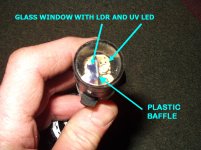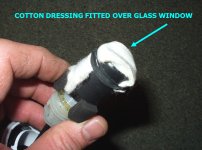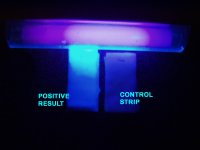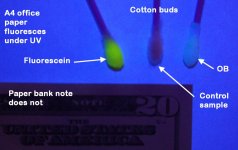Put the charcoal granules under test into dilute NaOH, a dash of isopropyl alcohol, then heat up and swill around. The green dye is released back into the liquid. It is then more easily noticed under UV light. Obviously you are going to wear some eye protection, aren't you.
The OB method is an easier process because the least you need to do is recover the strip of cotton wool dressing from the stream and test alongside a 'control strip' that has not been exposed to OB using a UV lamp. Boots sells 5x5cm sterile packs of these dressings, easily cut up into smaller test strips. My photos show such a strip attached to a DIY electronic detector where the data logger turns on the UV LED for couple of seconds when it wants a reading, say every 15 minutes, and measures the reflected visible blue light passing through a blue perspex filter glued on top of a light dependent resistor (LDR) configured to produce a significant voltage which is then logged.
If you don't have a UV lamp then any old UV LED wired to a couple of AA batteries will do. You can test this with office issue A4 white paper, all of which contains OB, as a control use a paper banknote which does not, and your cotton swabs. The cotton bud doped with Tinopal (on the far right in my photo) fluoresces in much the same way as A4 paper does. My cotton buds are formed on to mauve coloured plastic sticks, by the way, that hue has nothing to do with the UV LED!







